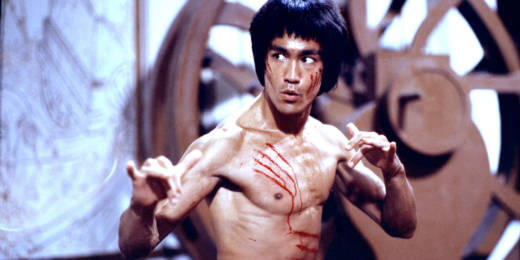Before martial arts films, Lee was a child actor in Hong Kong.
He played mostly dramatic roles. One film, The Orphan, actually made him a bit of a celebrity there — his performance was compared to James Dean's in Rebel Without a Cause.
But any fame he had quickly disappeared when he left Hong Kong for the U.S., where he moved when his family felt he was getting in too much trouble at home. Lee, who had been a martial arts student since his early teens, decided to make a living as an instructor.
He didn't plan on acting but was discovered by a TV producer. William Dozier, who produced the popular Batman TV series, cast Bruce Lee as sidekick Kato in The Green Hornet.
The Green Hornet debuted on ABC on Sept. 9, 1966. Oddly enough, the original Star Trek series, featuring George Takei as Sulu, premiered the same week. Both shows were significant for casting Asian-American males in prominent roles on TV.
That was far from the norm.
"Up until The Green Hornet, it really was pretty much a wasteland as far as Asian-American continuous representation on television," says Jeff Yang, a writer and host of the podcast They Call Us Bruce.
The Green Hornet didn't catch on like the Batman series and was canceled after only a year. After a few more guest spots on TV and a movie, Lee was ready to play a new type of character — one that didn't yet exist for Asian males in Hollywood.
"What Bruce Lee wanted to do was to create a heroic Asian male character," says Matthew Polly, author of the new biography Bruce Lee: A Life. "But it simply didn't exist. There were only two types of roles — Fu Manchu, the villain, and Charlie Chan, the model minority. And both of these characters were played by white actors in multiple films during the '50s and '60s."
It was about this time Lee caught a lucky break.
He went back to Hong Kong to visit family and was greeted at the airport by producers eager to cast him. It had been over a decade since his last role in Hong Kong, but The Green Hornet had been playing there — except there it was called The Kato Show. Lee was again a star.
He decided to make martial arts films for Hong Kong audiences. He made three: The Big Boss, Fist of Fury and Way of the Dragon. All were hits in Hong Kong. So Lee reached out to a producer he knew at Warner Brothers.
Which is where Enter the Dragon, well, enters. A co-production between Lee's Hong Kong studio, Golden Harvest, and Warner Brothers, it was the first martial arts film produced by an American studio. Lee was finally the heroic Asian star of a Hollywood movie. And he kicked butt.
Lee died a month before the film's release in the U.S. and didn't get to see the lasting influence it would have.
"Without Enter the Dragon most of the video games that we associate now with martial arts — certainly all of the television shows and films that have come afterwards ... would not be the same," Yang says.
"You know, we take for granted now that Hollywood action movies, they have martial arts, they have fight choreography, they do all this amazing stuff," says Phil Yu, the writer behind the site Angry Asian Man. "Before then we hadn't really seen martial arts in that context in a Hollywood film."
Lee's influence stretched beyond the screen. The Wu-Tang Clan's first album, one of the landmarks of hip-hop, was called Enter the Wu-Tang (36 Chambers) in honor of Lee's last film.
"Man, I used to bang my hands on the wall trying to get iron palms, scrape my hands with beans," says the RZA. "I got stretch marks on my shoulders because of kung fu things I was trying to do."
Forty-five years after his death, Lee still turns up all over popular culture — just this week, Quentin Tarantino announced a new actor in his upcoming 1969 period piece, Once Upon A Time In Hollywood. The role? Bruce Lee.
Copyright 2018 NPR. To see more, visit http://www.npr.org/.9(MDAxOTAwOTE4MDEyMTkxMDAzNjczZDljZA004))

9(MDAxOTAwOTE4MDEyMTkxMDAzNjczZDljZA004))

